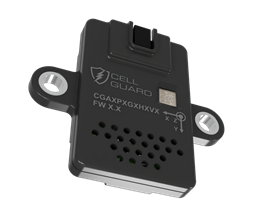Read this article in 中文 Français Deutsch Italiano Português Español
Successful tests of Cell Guard battery pack sensor system
27 March 2024
 Cell Guard sensor (Photo: Metis Engineering)
Cell Guard sensor (Photo: Metis Engineering)
Sensor specialist Metis Engineering has released the results of independent testing covering its Cell Guard system, which is intended to deliver advanced detection of a thermal runaway event in electric vehicle battery packs.
The tests, which were carried out by Sandia National Laboratories, involved Metis’ Cell Guard system and products from two competitors; one intended for use primarily with battery-electric storage systems (BESS) and another for EV applications.
The results, published in the Journal of the Electrochemical Society, showed that Cell Guard detected possible thermal runaway signatures in less than a minute and up to seven minutes faster than the other test products.
The sensors produced by Metis have a wide range of sensing capabilities which support early detection. Where most commonly use temperature and voltage change to identify a potential runaway scenario, the Cell Guard sensors can detect volatile organic compounds (VOCs) emitted during cell venting – a precursor to thermal runaway.
In addition, the sensors can detect humidity and dew point (to help cooling), with the option of adding a three-axis accelerometer to measure shock loads.
One of the sensors in the test is designed to identify hydrogen as a signal for thermal runaway. But this is only produced at temperatures of around 200ᵒC when the battery cathode starts to decompose - and just one minute before uncontrolled thermal runaway takes hold.
 Battery cell venting (left) in advance of thermal runaway (Photo: Metis Engineering)
Battery cell venting (left) in advance of thermal runaway (Photo: Metis Engineering)
Early detection of thermal runaway is critical. It can allow preventative measures to be taken to stop a related fire, while also allowing time for the vehicle operator and any passengers to exit before the situation becomes more dangerous.
Joe Holdsworth, managing director at UK-based Metis Engineering, said: “We are delighted that our Cell Guard sensor has proven its mettle against two competitors in the market in an entirely independent and third-party test. Not only did our sensor detect a thermal incident in under 60 seconds, the CAN data it provides could be used to inform the driver to stop and evacuate the vehicle.”
Data collected by the Cell Guard sensors can also be used to complement information collected by the battery management system to give a more accurate estimation of overall battery pack health, which should help to support second-life for electric machines.
POWER SOURCING GUIDE
The trusted reference and buyer’s guide for 83 years
The original “desktop search engine,” guiding nearly 10,000 users in more than 90 countries it is the primary reference for specifications and details on all the components that go into engine systems.
Visit Now
STAY CONNECTED




Receive the information you need when you need it through our world-leading magazines, newsletters and daily briefings.
CONNECT WITH THE TEAM













